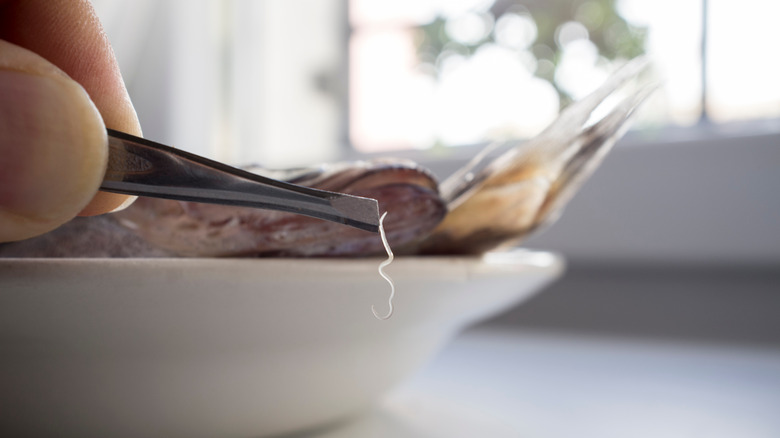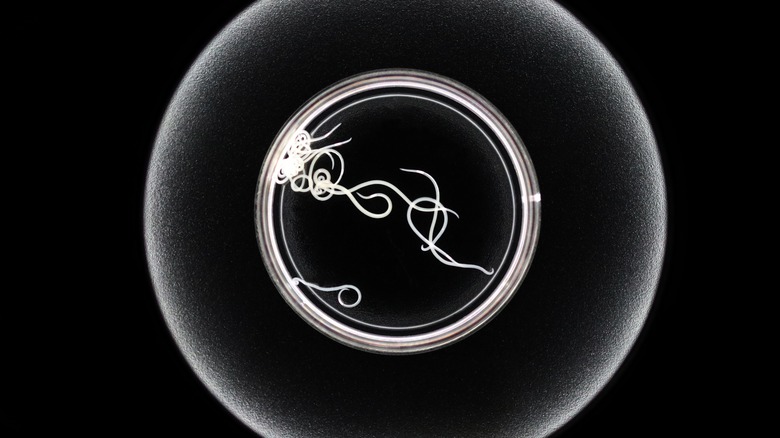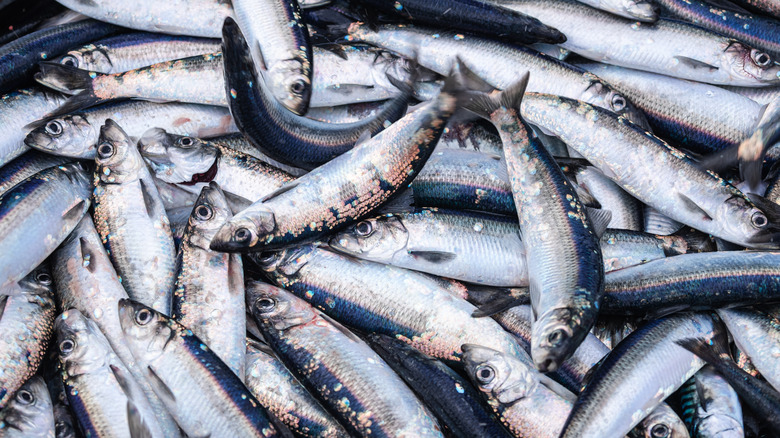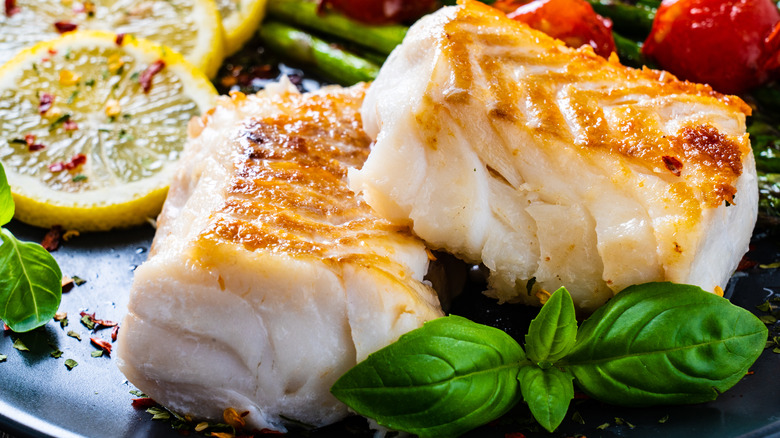What Is Cod Worm And Can It Make You Sick?
It's never good when something in your food is still moving. In the case of cod and other seafood products, what's moving is likely a parasitic nematode, that in scientific literature is known as an anisakid, but is more commonly referred to as cod worm or seal worm.
The bad news is that these parasitic worms are now found in a rather varied amount of seafood species, although the host species that have caused infections in humans vary from region to region. In the U.S., for example, the list of these fish encompasses mackerel, salmon, red snapper, and sablefish. While the worm is frequently associated with cod, this white fish has led to complications in other regions, as have various other types of fish and shellfish.
The good news is that there are at least two surefire ways to kill these worms, like cooking or freezing your fish to requisite temperatures, each of which renders their presence in your food harmless, according to the Centers for Disease Control and Prevention (CDC). Sure, it's still gross if you know you have dead cod worms in your fish or shellfish. However, that's certainly preferable to the alternate scenario where these worms can induce illnesses, ranging from allergic reactions to more severe health problems. The CDC has reported instances where these parasitic nematodes needed to be surgically removed from a patient's gastrointestinal tract.
How cod worms infect fish and shellfish
How do these live worms end up in so many seafood species? It starts with large marine mammals like sea lions, dolphins, or whales, which become infected and excrete worm larvae into the ocean. These larvae then become part of the food chain, and end up infecting many other smaller seafood species like fish and shellfish.
These tiny worms (the biggest are scarcely 1 inch in length) eventually end up in the intestines of fish, many of which are then caught by fishermen and enter our food chain. If these fish (or shellfish) were cleaned properly when caught, then the worms wouldn't be an issue. That's because the fish intestines are typically thrown out during the filleting process. But if the fresh catch is thrown in a refrigerated fish hold instead, one not cold enough to kill these parasites, then the worms relocate to the fleshy part of the fish and survive — sometimes until someone makes an awful discovery on their dinner plate after being served an undercooked entrée.
Even worse is the discovery of live worms after one has eaten infected fish. Then what happens, in the best of cases, is a crawly feeling in one's throat. That's the worm trying to get out. It's awful, but the worm being coughed or vomited up is actually the best possible scenario. If they reach a human intestine, then endoscopy or surgical interventions to remove them become a very real possibility.
Countries with the most cod worm infections and related diseases
Anisakiasis, as infection by cod worms is known, remains relatively rare in the U.S. A 1986 study published in the National Library of Medicine, for instance, noted that only 24 cases had been confirmed in the previous 13 years. More recent data is harder to find, with the CDC observing only that cases do occur in the U.S., but that infections happen much more frequently in countries where raw fish is eaten.
Japan, the home of sushi, is notable in this regard. Recent estimates (via Food Safety News) suggest that as many as 20,000 people in Japan may have been infected annually in recent years. Spain, meanwhile, leads the way in Europe with 8,000 or so cases of anisakiasis reported annually, per a journal published by the Switzerland-based open access publisher MDPI. A study of diseases resulting from parasitic worms in Spain was shared in the journal Clinical Infectious Diseases in 2019, and its authors concluded that although hospitalization is actually quite rare, the worms do indeed attack the gastrointestinal tract of their human hosts.
Fortunately, cod worms can't reproduce in humans, nor is their presence contagious. If you like seafood and are worried about possible infections by cod worms, don't eat raw fish, and make sure you follow CDC guidelines regarding cooking and freezing fish.
The two surefire ways to kill cod worms
Back in 1990, when cod worms were still relatively unknown, The Washington Post recommended freezing fish or cooking them at certain temperatures to make sure their parasites couldn't survive. These are still the two surefire ways to kill the unwanted worms, but in the intervening 33 years, the U.S. Food and Drug Administration (FDA) has tightened up the temperature specifications by a few degrees.
The quickest way to freeze your fish safely is to make sure the food reaches a solid state at -31 degrees Fahrenheit, and then is kept at that temperature for 15 additional hours. If your freezer doesn't get this cold, then another option is to store the fish at -4 degrees Fahrenheit for at least one week. Cooking, by contrast, is a much quicker and easier method. Simply bring the internal temperature of the fish to a minimum of 145 degrees Fahrenheit, and it's done. No cod worms can survive at this temperature.




